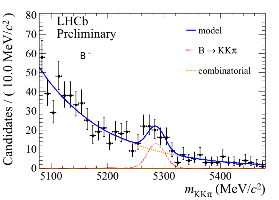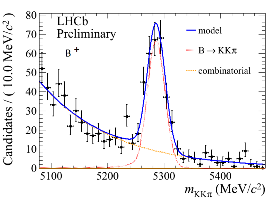[ ACP(B±→π±π+π–) = +0.120 ± 0.020 ± 0.019 ± 0.007 ]
[ ACP(B±→π±K+K–) = -0.153 ± 0.046 ± 0.019 ± 0.007 ]
Earlier this year, LHCb physicists reported at the ICHEP2012 Conference (see 7 July 2012 (2) news) the first evidence of inclusive CP asymmetry (differences between properties of matter and antimatter) in the charmless three-body B meson decays B±→K±π+π– and B±→K±K+K– in which the b-quark decays into a u,d or s-quark instead of its dominant decay into a charm c-quark. It was interesting to note that much larger asymmetries were observed in some small special regions, like invariant mass squared of the π+π– pair in the K±π+π– decay lower than 1 GeV2, or of the K+K– pair in the K±K+K– final state between 1.2 and 2 GeV2 (7 July 2012 (2) news).
click the image for higher resolution
These measurements have now, at the 7th International Workshop on the CKM Unitarity Triangle, Cincinnati, Ohio, USA, been complemented with results from the rarer B±→π±π+π– and B±→π±K+K– decays, finding evidence of even larger CP violation. A remarkable feature of the new LHCb results is that the CP violation effects appear to arise in some special kinematical regions that are not dominated by contributions from narrow resonances. For example, in B±→π±K+K– decays a broad feature at low K+K– invariant mass that was previously observed by the BaBar collaboration [PRL 99 (2007) 221801] appears to be present only in B+ decays, as shown by the filled triangles distribution in the left figure above, and not in the B– distribution (open triangles). This points to some interesting hadronic dynamics that could generate the observed direct CP violation. LHCb is now starting detailed studies of these channels, that can also exploit the three times larger data sample available after 2012 running, to further understand these effects. The results of these analysis will also establish whether the observed CP violation is consistent with the Standard Model expectation or has a more exotic origin.
The middle and right images above show the π±K+K– invariant mass distribution for B– and B+ decays with m2K+K– < 1.5 GeV2/c4. The difference between properties of matter and antimatter, the CP violation, is clearly seen as a difference between the height of two peaks located at the B mass (at 9σ level for experts).
More details can be found in the CERN Courier article, in the LHCb presentations in Cincinnati and in the CERN seminar here.



